joinin打印六年级下册英语复单元教案
六年级下册英语教案- Revision 2 join in 剑桥英语
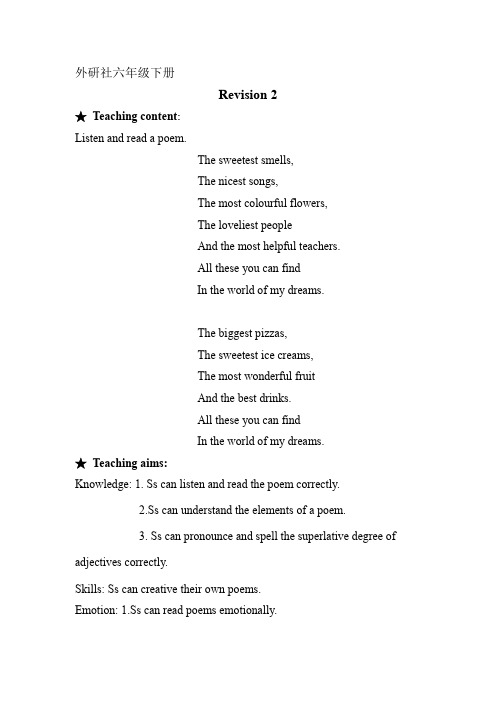
外研社六年级下册Revision 2★Teaching content:Listen and read a poem.The sweetest smells,The nicest songs,The most colourful flowers,The loveliest peopleAnd the most helpful teachers.All these you can findIn the world of my dreams.The biggest pizzas,The sweetest ice creams,The most wonderful fruitAnd the best drinks.All these you can findIn the world of my dreams.★Teaching aims:Knowledge: 1. Ss can listen and read the poem correctly.2.Ss can understand the elements of a poem.3. Ss can pronounce and spell the superlative degree of adjectives correctly.Skills: Ss can creative their own poems.Emotion: 1.Ss can read poems emotionally.2. Ss can think about their dreams deeply and how to realize their dreams.★Important teaching points:Ss can listen and read the poem.Ss can use the superlative degrees exactly.★Difficult teaching points:Ss can understand the elements of a poem and learn to write.★Teaching process:Step 1.Warming up1.Play a song Have a dream before class.2.Talk about the feelings and dreams.T: How are you today?S1: Fine. S2: So so. S3: ...T: I’m very happy and excited for two reasons. So many teachers are with us and enjoy our lesson. How happy we are to have friends afar.Last night, I had a nice dream.T: Did you have a dream? What kind of dreams did you have?Do you often have dreams? What kind of dreams do you have?S1: ... S2: ... S3: ....【设计意图:通过歌曲和自由谈话导入主题,与学生增进师生情感,营造轻松愉悦的教学氛围,同时巧妙引导出目标语言。
剑桥(join in)版小学英语六年级下册配套教案(全册)

教案设计教案设计Unit 1 My cousins and I教学设计(第1课时)【教学内容】Part 1, Part 2, Part 3【教学目标】(一)知识与技能1.能借助图片听懂、读懂介绍自己、家庭成员以及家乡的短文,并完成填空等练习;2.能读懂询问个人及家庭的问句,进行简单交流,并能简单记录和书面表达朋友及其家庭信息;3.能听懂描述个人外貌及性格特征的句子,并能准确认读和书写形容词nice,kind,pretty,lovely,friendly,outgoing,tall,short,strong,cool,clever,beautiful等。
(二)过程与方法1.以小组合作与情景教学为主,运用游戏帮助学生理解与运用所学知识;2.指导学生通过听音获取正确的信息,掌握一定的听音技巧。
(三)情感、态度与价值观帮助学生了解如何用英文介绍自己、家庭成员以及家乡。
【教学重点】使学生学会认读描述人的单词nice,kind,pretty,lovely,friendly,outgoing,tall,short,strong,cool,clever,beautiful等。
【教学难点】学生能通过听音获取正确的信息;能与伙伴们进行对话。
【教学准备】教材相配套的录音带【教学过程】Step 1 Warming up1.利用照片、课件创造情境,引导学生猜测单词词义。
2.呈现本课人物图片,引导学生提问,如“Who’s she? Where is she from? How old is she? What does she look like?”等。
Step 2 Listen and read老师播放录音,学生跟读课文,训练学生口语。
Step 3 Listen and practice1.老师再次播放录音,补充一些问题引导学生进一步理解短文。
如:Answer the questions:1) Where was she born?2) How old is she?3) What does she like?4) When did she start playing the piano?5) How many people are there in her family? Who are they?6) Where is her dad from? What about her mum?7) What do her parents do? And there where do they work?8) How old is her brother?2.学生独立完成1b练习,师生共同核对答案。
剑桥(join in)版小学英语六年级下册教学计划
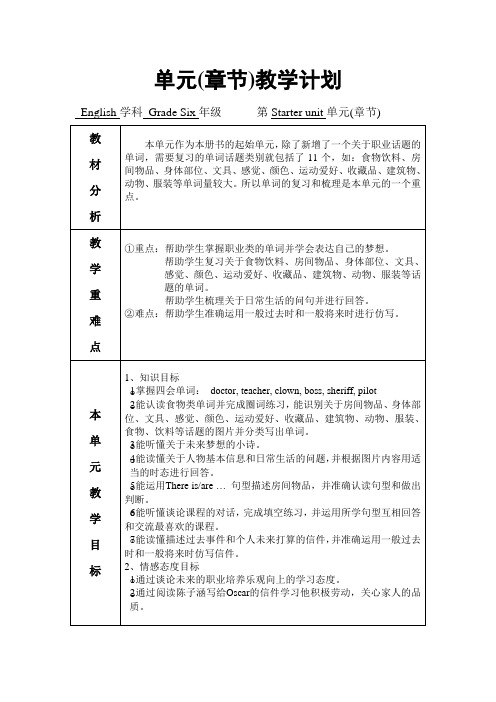
能听懂谈论周末计划的对话,并借助图片理解、认读单词或词组:listen to music, go riding, do maths exercises, read, play football, watch TV, play table tennis, paint,并完成排序和补充句子的练习。
教
学
重
难
点
①重点:帮助学生掌握职业类的单词并学会表达自己的梦想。
帮助学生复习关于食物饮料、房间物品、身体部位、文具、感觉、颜色、运动爱好、收藏品、建筑物、动物、服装等话题的单词。
帮助学生梳理关于日常生活的问句并进行回答。
②难点:帮助学生准确运用一般过去时和一般将来时进行仿写。
本
单
元
教
学
目
标
1、知识目标
单元(章节)教学计划
English学科Grade Six年级第Starter unit单元(章节)
教
材
分
析
本单元作为本册书的起始单元,除了新增了一个关于职业话题的单词,需要复习的单词话题类别就包括了11个,如:食物饮料、房间物品、身体部位、文具、感觉、颜色、运动爱好、收藏品、建筑物、动物、服装等单词量较大。所以单词的复习和梳理是本单元的一个重点。
教学进度
时间
教学内容
课时
备注
Part 1
1
Part 2、3
1
Part 4、5、S3
1
Part 6a、6b、7
1
单元(章节)教学计划
English学科Grade Six年级第Revision 1单元(章节)
教
材
分
析
Join in 六年级下册教案 Unit 6 The world of my dreams

Unit 6 The world of my dreams1st period part1 and part2Ⅰ. Teaching contentsUnit 6 Part1 Listen and readPart 2 Listen and numberⅡ. Teaching aimsTo help the ss understand the texts of the dreams.To help them finish the exercise.To help them improve the abilities of listening and reading.Ⅲ. Key point and difficult pointTo make sure they can understand the texts about dreams.To make sure the ss can read the texts.To help them number the sentences correctly.Ⅳ. Teaching steps(1)Warming upThe teacher asks some questions about dreamsWhat do you often dream?Let them listen to the tape and think about the questionWhat are the three children talking about?Then learn the title of unit 6. The world of my dreams.(2)PresentationThe teacher let the ss listen to the three texts one by one, asks them to find out the scenes accordingly.Then, helps the ss read the texts, get information about their world of dreams.The teacher asks a question“What is it like in the world of their dreams?”Let the ss read by themselves and underline key words and phrases on their books.Then check the answer and teach them new words and phrases.“Beautiful houses with big gardens, friendly, each other, live together in peace, no wars.”Listen again,let the ss read the texts after the tape.Then, read the texts group by group and read them together.(3)PracticeThe teacher gives an example of her world of dreams.Let the ss learn the text and write a new text.Asks the ss to work in groups, talk about their worlds of dreams.Choose several groups to present in front of the class.The teacher gives help if necessary.(4)Listen and numberLet the ss read the six sentences on page44.Listen to the several times and number the sentences.Check the answers.Asks the ss to read the sentences in correct order.Choose some ss to read the sentences and give comments.(5) HomeworkRead three texts of part 1.2nd period part3Ⅰ. Teaching contentUnit 6 Part 3 Talk about the world of your dreamsⅡ. Teaching aimsTo help the ss understand the new words and phrases of part3.To help them master the original level, comparative and superlative degree of adjectives.To help them talk about the world of their dreams.Ⅲ. Key point and difficult pointTo make sure the ss can use the original level, comparative and superlative degree of adjectives. To make sure they can talk about the world of their dreams clearly.Ⅳ. Teaching steps(1)Revision and warming upThe teacher asks the ss to read the texts of part1.Then asks some ss to read the texts loudly in front of the class.(2)PresentationThe teacher shows the pictures of robots, computers, gardens and playgrounds.The teacher introduces her world of dreams.Presents the original level, comparative and superlative degree of adjectives.Let the ss know th e meaning of “big bigger biggest/ friendly friendlier friendliest”Then the teacher helps the ss talk about their world of dreams.Asks some ss to show their dreams in front of the class.(3)PracticeLet the ss talk about their dreams with their partner.The teacher gives them help when they need.Asks the ss to read the content of part 3,helps them understand “bigger biggest, more beautiful,most beautiful”with the help of pictures and gestures.Divide whole class into groups of two. Let them talk about their dreams in pairs.The teacher gives help if necessary.Asks several ss to show in front of the class.(4). HomeworkRead part3. Write a text about their dreams.3rd period part 4Ⅰ.Teaching contentUnit 6 Part 4 A story-The rabbit’s dreamⅡ. Teaching aimsTo help the ss understand the story.To help them learn the new words in the story.To help the ss improve the ability of listening.Ⅲ. Key point and difficult pointTo make sure the ss can understand the new words.To make sure they can understand the plot of the story.To help them retell the story.Ⅳ.Teaching steps(1)Warming upThe teacher asks the ss to answer “What’s your dream?”Let the ss talk about their dreams.(2)PresentationThe teacher shows the picture of rabbit. Let the ss listen to the story and answer the question. “What’s the rabbit’s dream?”Let the ss got a general idea about the story.Listen again. Let the ss answer “How many animals does the rabbit meet?”Ask one student to answer.Then ask them to fill in the table.Let the ss read picture one to four, and then answer the following questions:①What does the rabbit ask?②How does the lion answer?③What does the lion want to do?④What does the rabbit do?Let the ss fill in the table.Check the answers.(3)PracticeLet the ss read the rest of the pictures, find out the ending of the story by themselves.Asks the ss to listen to the story sentence by sentence, and imitate the pronunciation and intonation.Read the story together.Ask some ss to act out the story and the teacher gives comments.Then, the teacher asks the ss to retell the story, and asks some ss to show in front of the class. Gives praise.(4)HomeworkRead the story4th period part 5Ⅰ.Teaching contentUnit 6 part 5 Listen and sing the songⅡ.Teaching aims1.Make sure the Ss can understand the song.2.Make sure the Ss can read and sing the song.3.Make sure they like this song and then talk about their own dreams.Ⅲ. Key points and difficult points1.To help the Ss understand and sing the song.2.To help them talk about their own dreams.Ⅳ Teaching processesStep 1 warming up1.Free talk.2.Read the poem ------What I want to be.Step 2 Presentation and practice1. T: What do you want to be?What’s your dreams?Ss: Superstar, boss, doctor...T: Now, let’s listen to a girl’s dream and an swer this question: What is her dream about?Play the recorder and Ss listen.2. Ask some SS to answer the question. T can help if necessary.3.T can show her dream with the help of ppt and teach some new words: enough, wood, meet, kids and grown-ups.4.Listen to the song again and try to understand the whole song.5.Learn the song part by part, sentence by sentence.6.Sing the song after the recorder, and then sing the song in diverse ways.Step 3 ConsolidationJust now we know the girl’s dream. What about your d ream? Talk about your dream about the world and people, with the sentence structures below;I see...There are...Step 4 Homework1.Sing the song for your parents.2.Write your dream.5th period Part 6 Part 7I. Teaching contentsUnit 6 Part 6 Look and fill in the letters. Then listen and repeat.Part 7 Listen and read the dialogueII. Teaching aims1.Make sure the Ss can finish part 6 correctly.2.Make sure they can use the dialogues.3.Make sure they can read the dialogues in part 7.4.Make sure the Ss can understand the comparative degree and the superlative degree.III. Key points and difficult points1.The Ss can understand and read the conversations.2.The Ss can ask the way.3.The Ss can master the comparative and superlative degree of adjectives.IV. Teaching processesStep 1 revision1. Free talk.2.Read the passage of Beijing and Wuhan.Step 2 Presentation and practice1.Let’s look at other cities. Show some pictures of Nanjing, Wuhan and Shanghai.T can introduce those cities and teach some useful adj:small, big, friendly ,good, many, beautiful, expensive.Ask some Ss to describe those cities with those adj.2.T shows the area of the three cities and asks: Which city is the smallest, Shanghai, Wuhan or Nanjing? Teach the superlative degree.T can give some examples:Tom is the tallest in our class.This box is the biggest.Ask some Ss to make sentences. Then answer the question above.3. Show the area of Wuhan and Nanjing and ask: Which is smaller, Wuhan or Nanjing?Teach the comparative degree in the same way.4.T asks: Which city is the biggest, Shanghai, Wuhan or Nanjing?Ask some Ss to answer.T: Which is bigger, Wuhan or Nanjing?Ask some Ss to answer5.T: If you are new in a city. You want to the museum. How to ask the way?Ss: ...You want to buy an ice cream. What can you say?Ss:...Practice the remaining two scenarios in the same way.6.Fill in the letters in part 6.Then listen and repeat.7.T and Ss act the dialogues and the let the Ss make dialogues like this.Step 3 HomeworkRead the dialogues in part 6 and part 7.。
joinin打印小学六年级下册的英语2—3单元复习学习教案
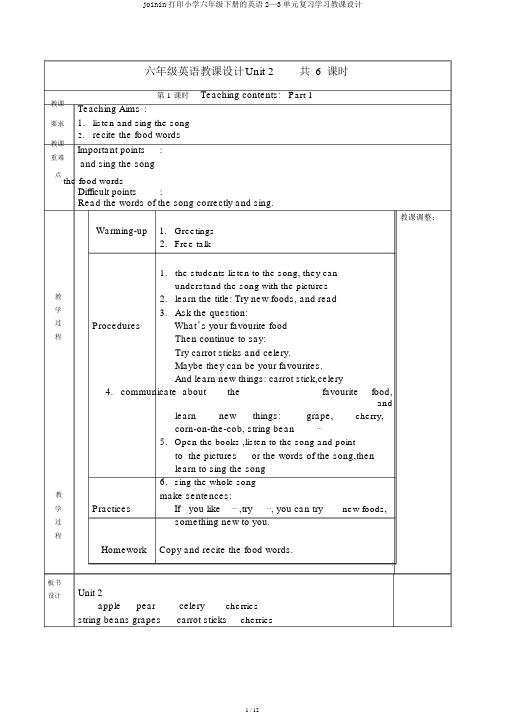
六年级英语教课设计Unit 2共6课时第 1 课时Teaching contents:Part 1教课Teaching Aims :要求 1.listen and sing the song2.recite the food words教课Important points:重难and sing the song点the food wordsDifficult points:Read the words of the song correctly and sing.教课调整:教学过程教学过程板书设计Warming-up 1.Greetings2.Free talk1.the students listen to the song, they canunderstand the song with the pictures2.learn the title: Try new foods, and read3.Ask the question:Procedures What’s your favourite foodThen continue to say:Try carrot sticks and celery.Maybe they can be your favourites.And learn new things: carrot stick,celery4. communicate about the favourite food,andlearn new things:grape,cherry,corn-on-the-cob, string bean⋯5.Open the books ,listen to the song and pointto the pictures or the words of the song,thenlearn to sing the song6.sing the whole songmake sentences:Practices If you like⋯,try⋯, you can try new foods,something new to you.Homework Copy and recite the food words.Unit 2apple pear celery cherriesstring beans grapes carrot sticks cherries六年级英语教课设计Unit 2第 2 课时Teaching contents:Part 2 & Part 3教课要求Teaching Aims :1.Know the food rainbow.2.Ask and answer:What ’s you favourite foodMy favourite food is⋯e the sentences structmentbe good for⋯be bad for⋯教课Important points:重难Learn to read and use the sentence patterns点Difficult points:and answer:What’ s you favourite food My favourite food is⋯教课调整:教学过程教学过程板书设计Warming-up 1.Greetings2.Listen and sing the song<Try new foods>1.Free talk:What is your favourite food2.divide the food into several categories:fruits, vegetables, sweets, drinks,⋯Procedures 3.Pay attention to fruits and vegetablesClassify the fruits and vegetables by colours4.Answer the questions:What is your favourite red/⋯ food5.Write down their favourite food for eachcolour in the rainbowCheck the answers.Read the sentences one by one in rows6.furits and vegetables with different coloursare good for different bodies.Try to use the sentence patterns:⋯ is/are good for⋯Practices Write on the notebooks, read in different wayscorrectly and skillfullyRead , translate and recite the right sentences Homework in Part 3.Unit 2 Food and healthfruits red:tomato⋯vegetables orange:orange⋯food sweets yellow:lemon⋯drinks green:watermelon⋯blue:grape⋯教课要求教课重难点教学过程教学过板书设计六年级英语教课设计Unit 2第 3 课时Teaching contents:Part 4 & exercises books & supplementary activities 1Teaching Aims :1.Look at the pictures and read the words, then recite.2.Read and understand the dialogues.3. Discuss which foods are good for health, and which foods are bad for health.4.do exercises correctlyImportant points:at the pictures and read the words, then recite.and understand the dialogues.Difficult points:do exercises correctly教课调整:1.Greetings2.Exercise books:Warming-up Page 20 I:Listen and choosePage 17: II: Listen and circle.1.look at the pictures, read the food words2.divide into two categoriesbe good for our healthbe bad for our health3.look at the chart on the board and makesentences to talkProcedures⋯be good for our health⋯be bad for our health⋯be healthy⋯ be not healthy4.Page 61,do exercises:Tick what’s good for your healthExercise books:I:Listen and number.Practices III: Listen and tick of cross.Exercise books:Homework Page 18 V: Look and writeThen recite the wordsUnit 2⋯is/are good for our health⋯is/are healthy⋯is/are bad for our health⋯is/are not healthy六年级英语教课设计Unit 2第 4 课时Teaching contents:Part 5 & exercise books教课要求Teaching Aims :and understand the label.the eating habits and write down your own healthy eating tip cards.教课重难Important points:点Read and understand the label.Difficult points:Discuss the eating habits and write down.教课调整:教学过程教学过程板书设计1.Greetings2.Free talkWarming-up My favourite food is⋯ , it is/are good formy health.1.Exercise books:VI: Read, choose and writeLearn the newthings:whole grains, junk food,whole-wheat breadRead the words and understand.2.Exercise book:Page 22 V: Look , read and tick.Procedures 3.We need:4.point to the books and listen to the mp35.listen and read the sentencespay attention to the words:exercise, plenty of⋯6.drill to read the sentencesExercise book:Practices Page 19 VII: Read and write“ T” or“ F”Homework Page 21 III: Listen and writeUnit 2 Food and healtheat more⋯eat plenty of⋯drink⋯do more exercises教课要求教课重难点教学过程板书设计六年级英语教课设计Unit 2第 5 课时Part 6a & 6bTeaching Aims :1. Listen ,read and understand the dialogues.2.Listen and number Nick’s answers.3.Listen and match Ann ’s questions with Nick’s answers in 6a.Important points:Listen ,number and match the exercises.Difficult points:Listen, read and understand the dialogues.教课调整:1.GreetingsWarming-up 2.Sing the song <Try new foods>3.Read Part 5.1.look at the picture of the boy Nick, tell thepupils to learn the new words: fit, strong2.T asks the pupils:Why is he so fit and strongLead the pupils to answer according to thecontents in part 53.listen to the mp3, the pupils feel thedialogues4.show the corresponding pictures and theProcedures sentences,understand and learn to read them:I do a lot of exercises everyday.I sleep for 8 or 9 hours every night. etc.5. open the books to page 18, read the sentencestogetherPractices Groupwork:Discuss: How can we be fit and strongThen write the advices .HomeworkCopy the questions and the answers, then read.Unit 2 Food and health,Nick! Why are you so fit and strong.I do a lot of exercise every day.六年级英语教课设计Unit 2第 6 课时Part 7a & 7b教课Teaching Aims :要求1.listen and read the text2. read again and underline Auntie Pang’s bad habits.Then answer the questions.教课Important points:重难Listen, read and understand the text.点Difficult points:Read the text and answer the questions correctly.教课调整:教学过程教学过程Warming-up 1.Greeting2.Read the dialogues between Ann and Nick.1.Show the picture of Auntie Pang,Think: Who ’s she2.listen and try to understand the story,choose the right answer:Procedures Who’s sheA. Auntie PangB. Granny Pang3.listen to the mp3again, understand the story againthen do exercises to check:and repeat the storypupils read the story together ,then read in groupsin classthe text alone and underline Auntie Pang’s badhabits.Practices Read out Auntie Pang’s bad habits.to read the questions and answer3.Check the answers in class.Homework Write out Auntie Pang’s bad habits.板书设计Unit 2loves eating very much.→But her eating habits are not healthy!→She likes eating pizza, hamburgers, and ice cream.She eats a lot and drinks too much cola every day六年级英语教课设计Unit 3共6课时教课要求第1课时 1Teaching aims :1.Listen and read the passage about Mary and one of her diaries. Grasp useful information to do Ex.教课Important points:重难1.Read the passage in 1 and answer some questions.点2. Be able to complete the retelling passage about Mary in 1, using theinformation they ’ve got in the passage.Difficult points:1.Be able to complete the retelling the passage in 1, using the informationthey ’ve got in the passage.教学过程1.Greetings教课调整:Warming-up2.Show a photo of a diary to lead in the topicand teach the new vocabulary:diary, keep a diary1.Listen and read the first short passage aboutMary and fill in the form.2.Read the passages again and complete theretelling in the first person and then in thethird personProcedures I ’ m ⋯She is ⋯3.Read Mary’s first diary and pay attention tothe past forms: was, went, ate, wrotePractices 1.Talk about the pictures2.Retelling the passage in different persons.Homework 1.Read the passage.板书设计Unit3diary, keep a diaryhometown, beautiful, castle, lakewas(be), went(go), ate(eat), wrote(write)教课要求教课重难点教学过程教学过程板书设计六年级英语教课设计Unit 3第2课时2&3Teaching aims :1.Learn about the form of the English diary.Learn some new words.Important points:eful words2.The form of the English diaryDifficult points: Write a diary1.Greetings教课调整:Warming-up 2.Read the passages learnt in Period 11.Listen and read the passge in part2,and thendo “True or False ”exercise.1> Mary wrote this diary on a cloudy day.2> She isn ’t good at maths.3> She did five sums, but she only got fourProcedures right..2.Answer:1> Why was Mary sad2> Does Mary like Maths3> What will Mary do3.Listen and read the passage in part3,and thendo the “True or False ” exercise.1> Mary visited the old castle on 19th August.2> Mary visited the castle with her aunt.4.Answer:1> How old is the castle2> Does Mary think there is a ghost in thetower1.Make sentences by using the phrases:⋯be good at⋯Practices⋯ will work harder.2.Write the past forms: give—gaveget —got feel— felt visit —visiteddream— dreamed love — lovedHomework 1.Copy and recite the past forms.Unit 3give —gave get—got feel—felt visit—visited dream—dreamedlove —love六年级英语教课设计Unit 3第3课时 4&5教课 Teaching aims :要求1. Listen and read the story.Answer questions 教课 Important points :重难 1. Read and answer the questions.点Difficult points: Grasp the useful information accurately.1. Greetings 教课调整:Warming-up 2. Listen passage 3 in 1a and do True or Falsequestions.3. Read passage 3 and ask a question : What isLiza going to write about, China or Australia1. Listen and read the story and answer教 questions: 学 Picture1-2过1> What is there in the castle程2> What ’s its nameProcedures 3> Who takes the ice creamPicture3-5 1> What does Oswald love 2> What is he going to do 3> How much is the ice cream 4> Does he get the ice cream Why Picture6-13 True or False1> Oswald has got an idea of pretending( 假装 ) tobe a guide. 2> People don ’t like him.3> He have got money to buy ice cream. 教2. Read the story again and do on page 24.学Practices 1. Read the story in roles.过Homework 1. Read the story程Unit 3 stop shoutingwonderful great excellent板书 设计教课要求教课重难点教学过程板书设计六年级英语教课设计Unit 3第 4 课时6a & 6bTeaching aims :1. Practice the sentence patterns: What will⋯do⋯will+ 原型⋯Important points:1. Sentence pattern: What will⋯do⋯ will+ 原形⋯Difficult points:1. Sentence pattern: What will⋯do⋯will+ 原形⋯Warming-up 1. Greetings教课调整:1.Listen and number what Sally will do inthe correct order23142.Listen again and then fill in what Sallywill do this SaturdayProcedures will do maths exercisewill listen to musicwill go ridingwill read a storybookPractices 1.read and write the sentencesHomework Write some sentences by using the sentencepatterns.Unit 3What will⋯do⋯will+ 原形⋯教课要求教课重难点教学过程板书设计六年级英语教课设计Unit 3第5课时 5Teaching aims :1. Practice the sentence pattern: What is⋯going to do⋯ is going to +原型⋯Important points:1. Practice the sentence pattern: What is⋯going to do⋯ is going to +原型⋯Difficult points:1. Practice the sentence pattern: What is⋯going to do⋯ is going to +原型⋯Warming-up 1. Greetings教课调整:1. Look and answer what Simon is going to do thisweekend.He is going to play football on Saturday morning.He is going to watch TV on Saturday evening.He is going to play table tennis on Sunday Procedures afternoon.He is going to paint on Sunday evening2. Look at some pictures and make sentencesPractices 1.Make sentences.Homework 1. Make sentences ”Unit 3What is⋯going to do⋯ is going to +原型⋯六年级英语教课设计Unit 3教课要求教课重难点第6课时7&8Teaching aims :1.Understand the family tree in 7.Be able to fill the useful information in the table by asking and answering, and then report it to the class.Important points:1. Understand the family tree in 7.2. Be able to fill the useful information in the table by asking and answering, and then report it to the class.Difficult points:1. Fill the useful information in the table by asking and answering, and then report it to the class.1. Greetings教课调整:Warming-up教学过程1.Showa family tree with the families,such asfather mother grandfather etc.2.Showthe family tree and answer the questionsin 7.3. Take one as an example to complete thetable Procedures about their families by asking and answering.4.Help the Ss to Complete the table andask several Ss to report it to the class.1.Ask and answer in oral.2.Fill in the table in 8.Practices1. Write a passage about one of their families. Homework板书设计Unit 3What is⋯’s nameHow old is⋯What does ⋯ doWhat does ⋯ like。
Join in 六年级下册教案 Revision1
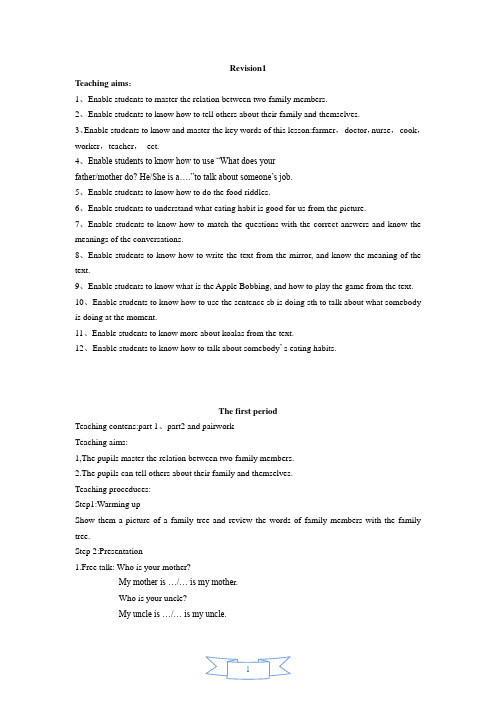
Revision1Teaching aims:1、Enable students to master the relation between two family members.2、Enable students to know how to tell others about their family and themselves.3、Enable students to know and master the key words of this lesson:farmer,doctor,nurse,cook,worker,teacher,ect.4、Enable students to know how to use “What does yourfather/mother do? He/She is a….”to talk about someone’s job.5、Enable students to know how to do the food riddles.6、Enable students to understand what eating habit is good for us from the picture.7、Enable students to know how to match the questions with the correct answers and know the meanings of the conversations.8、Enable students to know how to write the text from the mirror, and know the meaning of the text.9、Enable students to know what is the Apple Bobbing, and how to play the game from the text.10、Enable students to know how to use the sentence sb is doing sth to talk about what somebody is doing at the moment.11、Enable students to know more about koalas from the text.12、Enable students to know how to talk about somebody’ s eating habits.The first periodTeaching contens:part 1、part2 and pairworkTeaching aims:1,The pupils master the relation between two family members.2.The pupils can tell others about their family and themselves.Teaching proceduces:Step1:Warming upShow them a picture of a family tree and review the words of family members with the family tree.Step 2:Presentation1.Free talk: Who is your mother?My mother is …/… is my mothe r.Who is your uncle?My uncle is …/… is my uncle.2.Learn the new sentence:My uncle is my mother’s brother.3.Ss talk about their own family members.then learn the new sentence and practice.My mother has got a brother, he is my uncle.Step3:PractiseGive students enough time to talk about their family, then ask several students to tell their family to the class.Step4:HomeworkDo the exercise in part3 on page27.The second periodTeaching contens:part 3 and pairworkTeaching aims:1.Students can master the key words of this lesson:farmer,doctor,nurse,cook,worker,teacher,ect.2.Students know how to use “What does yourfather/mother do? He/She is a….”to talk about someone’s job.Teaching proceduces:Step1:warming up1.Show them a video about some different jobs, and ask students to find how many jobs are there in the video.2.Check the answer of part3 in page27 and circle the words of jobs.Step2:Presentation1.Read the words2.Show the video again and find out who is a nurse, who is a doctor and so on.3.The pupils talk about the person’s job in pairwork..Step 3 PracticeGive students enough time to talk about their family members’jobs, then ask several students to make dialogues with their partners and show their performances to the class.Step4 HomeworkCopy the new words: farmer,doctor,nurse,cook,worker and teacher.The third periodTeaching contens:part 4 and part5Teaching aims:1.Students to can do the food riddles by themselves.2.Students understand what eating habit is good for us from the picture.Teaching procedures:Step1 warming upGive the students a simple food riddle: I am round and orange. I am a little sour. And show them some actions to let them know what is it.Step2 Presentation1.Circle the new words and learn the new words at first.2.Do the food riddles by themselves and check the answers.3.Find out what food are there in the picture in part5, and what makes a healthy diet.4.Do the exercises in part5 and then check the answers.Step3:PracticeGive students enough time to make a simple food riddle by themselves and ask others to guess the answer. Then ask several groups to show their performances to the class.Step4:HomeworkMake your own healthy eating tip cards.The fourth periodTeaching contens:part 6 and part 7Teaching aims:1.Master the use of wh-questions2.To make the students understand the listening material3.Enable students to know how to write the text from the mirror, and know the meaning of the text.3.Teaching proceduces:Step1:Warming up1.Greetings.2.Check students’homework.Step 2:Presentation1.First,students need to read through the sentences so that they can know their meanings.2.Ask students to match and fill in the numbers.3.Finally,check the answers,4.Play the tape and students follow it.Step3:Practice1.Look at the picture,let’s see what Toby wants to do.You can use mirror to help you do it.2.Ask students to do this exercise individually.3.Then check the answers.Answers:Hi,Meet me tonightAt twelveUnder the big treeBehind the castle.Don’t be afraid.I always carry my headUnder my arm.Quentin ,the ghostStep4:Homework1.Practice reading the sentences in part62.Preview the next periodThe fifthth periodTeaching contens:part 8Teaching aims:1.Enable students to know what is the Apple Bobbing, and how to play the game from the text. 1.Be able to read and understand the short passage.Teaching proceduces:Step1:Warming up1.Greetings.2.Sing the song<<what are you doing?>>Step2:Presentation1、Teach the new words:wash Apple Bobbing big bowl of water2、Look at the picture carefully in Part8 so that students know what the boy is doing and how to do it?3.Read the passage loudly and Answer the questions:1.)What is the boy doing in the pictures?2.)Who likes playing the game?3.)When do children play the game?4.After students finish the work,check the answersAnswers:1.)The boy is playing a game.2.)Children in the UK and the USA like the game.3.)They play the game on Halloween.5.Listen to the tape and have students repeat sentence by sentence.Step3:PracticeLet’s play a gameInvite three students to the front to do this game of Apple Bobbing for the whole class.Step4:HomeworkRead the text in part 8The sixth periodTeaching contens:part 9,part 10 and part 11Teaching aims:1.Be able to use present progressive tense to talk about what sb is doing something.2.Enable students to know more about koalas from the text.3.Enable students to know how to talk about their somebody’seating habits4.Be able to complete the exerciseTeaching proceduces:Step1:Warming up1.Review the sentence..........is/are doing sth.Step2 Presentation1.Now,open your book and Look at the pictures in part9.What can you see in the pictures?What is Toby doing?Talk with your partner about them.2.Then complete the sentences individually.3.Students need to read carefully and choose a word in part10 to fill in each black.4. Finally,check the answers.Answers:Part 9 1.is riding 2.is writing 3.is reading 4.is sleepingPart10 live like are ooks eats sleepsStep 3 PracticeLook at the pictures in part11 and answer the questions.1.)What is he going to eat for breakfat?2.)Is he going to drink milk for lunch?What is he going to drink?3.)What grain food is he going to have for lunch?4.)Is he going to eat any fruit for lunch?5.)What is he going to eat for supper?Ask five students to write the answers on the blackboard.1.)He is going to eat an egg,a banana and some bread.2.)No,he is going to drink some juice for lunch.3.)He is going to have rice for lunch.4.)Yes,he is going to eat an apple for lunch.5.)He is gong to eat some noodles ,vegetables,fish,nut,soup and orange for supper. Step4:HomeworkUse the information above to write a short passage about Peter’s eating habits.。
(完整word版)JoinIn小学英语六年级下学期教学计划
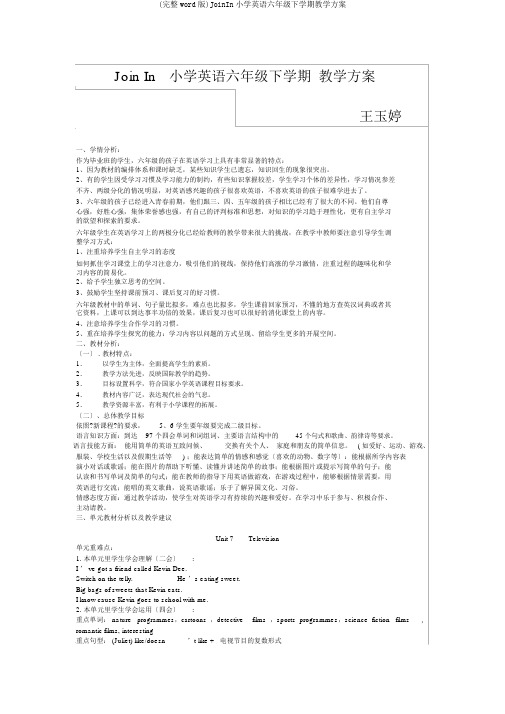
Join In小学英语六年级下学期教学方案王玉婷一、学情分析:作为毕业班的学生,六年级的孩子在英语学习上具有非常显著的特点:1、因为教材的编排体系和课时缺乏,某些知识学生已遗忘,知识回生的现象很突出。
2、有的学生因受学习习惯及学习能力的制约,有些知识掌握较差,学生学习个体的差异性,学习情况参差不齐、两级分化的情况明显,对英语感兴趣的孩子很喜欢英语,不喜欢英语的孩子很难学进去了。
3、六年级的孩子已经进入青春前期,他们跟三、四、五年级的孩子相比已经有了很大的不同。
他们自尊心强,好胜心强,集体荣誉感也强,有自己的评判标准和思想,对知识的学习趋于理性化,更有自主学习的欲望和探索的要求。
六年级学生在英语学习上的两极分化已经给教师的教学带来很大的挑战,在教学中教师要注意引导学生调整学习方式:1、注重培养学生自主学习的态度如何抓住学习课堂上的学习注意力,吸引他们的视线,保持他们高涨的学习激情,注重过程的趣味化和学习内容的简易化。
2、给予学生独立思考的空间。
3、鼓励学生坚持课前预习、课后复习的好习惯。
六年级教材中的单词、句子量比拟多,难点也比拟多,学生课前回家预习,不懂的地方查英汉词典或者其它资料,上课可以到达事半功倍的效果,课后复习也可以很好的消化课堂上的内容。
4、注意培养学生合作学习的习惯。
5、重在培养学生探究的能力:学习内容以问题的方式呈现、留给学生更多的开展空间。
二、教材分析:〔一〕 . 教材特点:1.以学生为主体,全面提高学生的素质。
2.教学方法先进,反映国际教学的趋势。
3.目标设置科学,符合国家小学英语课程目标要求。
4.教材内容广泛,表达现代社会的气息。
5.教学资源丰富,有利于小学课程的拓展。
〔二〕、总体教学目标依照?新课程?的要求,5、6 学生要年级要完成二级目标。
语言知识方面:到达97 个四会单词和词组词、主要语言结构中的45 个句式和歌曲、韵律诗等要求。
语言技能方面:能用简单的英语互致问候、交换有关个人、家庭和朋友的简单信息。
Join in 六年级下册教案 Unit 1 My cousins and I

Unit1 My cousins and I教学目标:1.能借助图片听懂、读懂介绍自己、家庭成员以及家乡的短文,并完成填空等练习。
2.能听懂、读懂有关堂/表兄弟姐妹及家庭成员的简短对话,并根据对话内容判断句子正误、回答问题等。
3.能读懂询问个人及家庭的问句,并能简单记录和书面表达朋友及其家庭的信息。
4.能听懂描述个人外貌及性格特征的句子,并能准确认读和书写形容词nice, kind, pretty,lovely, friendly, outgoing, tall, short, strong, cool, clever, beautiful等。
5.能看懂家庭树,并回答问题。
6.能在表格中准确记录关于家庭成员年龄、工作、兴趣爱好的信息并做汇报。
课时安排:七课时第一课时教学内容:part2教学目标:1.能认读家庭成员单词。
2.能读懂询问个人及家庭的问句,进行简单交流,并能简单记录和书面表达朋友及其家庭的信息。
教学重点:能认读家庭成员单词。
教学难点:能读懂询问个人及家庭的问句,进行简单交流,并能简单记录和书面表达朋友及其家庭的信息。
教学准备:课件,相片。
教学过程:Step1.Warming-upListen to the song :My familyStep2.presentation1.课件出示家庭的照片,引出课题My family。
2.借助图片介绍下列单词:father, mother, grandfather, grandmother, brother, sister.3.在教师的帮助下认读单词。
4.学生拿出自己家庭的照片,进行下列对话:S1:Who is he?S2:He is my father.S1: Who is she?S2:She is my mother.…Step3.Singing the song学生跟着磁带学唱歌曲My family.Step4.part21.师生自由对话,帮助学生回顾相关句型。
Join-in-小学六年级英语教学计划

六年级下册英语教学计划一、指导思想以全国教育会议为指针,以科学发展观为统领,以深入素质教育为中心,坚持以德育为首,教育为中心,坚持不懈地抓好教学工作,注重常规教学,求真务实。
二、总体目标1、以深入学习理论为突破口,进一步提高基础教育外语教学研究对课程改革的适应力,努力搞好教学研究、教学指导、教学服务等日常工作。
2、创造性开展外语教学,为转变教研职能,探索新形式下教研工作模式做出积极的努力。
3、以优化课堂教学为中心,以深化教学创新为思路,以提升教研效能为导向。
三、教材分析本册教材是新版Join In剑桥英语,共有6单元,知识跨度大,难度较大。
每课一个话题,同一单元的语言材料围绕这个话题展开。
话题与学生的日常生活、学习等密切相关,能使学生觉得熟悉、实用,既便于课堂教学的展开,又便于学会在实际生活和学习中套用与这些话题相关的句子,进行简单的交流。
本册书阅读篇幅较多,侧重培养学生阅读理解能力。
新授单元主要是从对话、阅读两个类型入手,情景对话着重训练学生的听说技能,提高会话能力。
阅读内容紧扣本单元话题,着重训练学生获取信息和读的能力。
复习单元基本上不含新单词和句型,它们通过形式多样、生动活泼的情景训练,有重点的复现了相关单元的主要语言点。
(二)教学要求和目标1、能按四会要求掌握所学的句型。
2、能运用日常交际用语,活用四会句型,进行简单的交流,并作到大胆开口,发音正确,所用话语与场合相符。
3、能掌握一定的阅读技能,提高阅读能力。
4、培养良好的书写习惯,能做到书写规范、整洁。
5、养成良好的听英语、读英语,说英语的习惯,能自觉的模仿语音、语调,逐步培养语感。
6、能在任务型学习的过程中运用相关的语言知识,完成某项任务,并促进语言能力的提高。
(三)教学重点难点分析重点:1、能按四会要求掌握所学句型。
2、能运用日常交际用语,或用四会句型,惊醒简单的交流,并做到大胆开口,发音正确,所用话语符合场合。
3、能掌握一定的阅读技巧。
Revision2(教学设计)-2023-2024学年joinin外研剑桥英语六年级下册

- 合作学习法:通过小组讨论等活动,培养学生的团队合作意识和沟通能力。
作用与目的:
- 帮助学生深入理解过去时态、形容词的比较级和最高级、现在完成时态、祈使句等语法知识,掌握语法技能。
- 通过实践活动,培养学生的动手能力和解决问题的能力。
- 通过合作学习,培养学生的团队合作意识和沟通能力。
4. 祈使句的构成:难点在于区分祈使句和陈述句的构成,以及正确运用祈使句进行表达。
在教学过程中,教师需要针对以上重点和难点进行有针对性的讲解和强调,通过示例、练习等方式帮助学生理解和掌握。同时,教师还可以采用小组合作、讨论等方式,激发学生的学习兴趣和参与度,提高他们的语言运用能力。
四、教学资源
1. 软硬件资源:多媒体投影仪、计算机、打印机等。
② 形容词的比较级和最高级
- 重点知识点:形容词的比较级和最高级的构成规则、用法。
- 板书设计:列出形容词比较级和最高级的构成规则,如“add -er/ -est, more/ most”;提供例句,如“He is taller than me.”;强调比较级和最高级的用法,如比较级用于比较,最高级用于最高程度。
- 学生作业分析:分析学生的作业,了解他们对语法知识点的掌握情况,以及在学习过程中遇到的问题。
- 教师观察与记录:在课堂上观察学生的学习表现,记录他们的参与程度、理解程度以及在学习过程中出现的问题。
2. 制定改进措施
根据以上反思活动,我将制定以下改进措施,计划在未来的教学中实施:
- 针对学生问卷调查的反馈,调整教学方法和内容,以提高学生的学习兴趣和理解程度。
- 解答疑问:针对学生在学习中产生的疑问,进行及时解答和指导。
201Xjoin in打印)六年级下册英语0—1单元教案
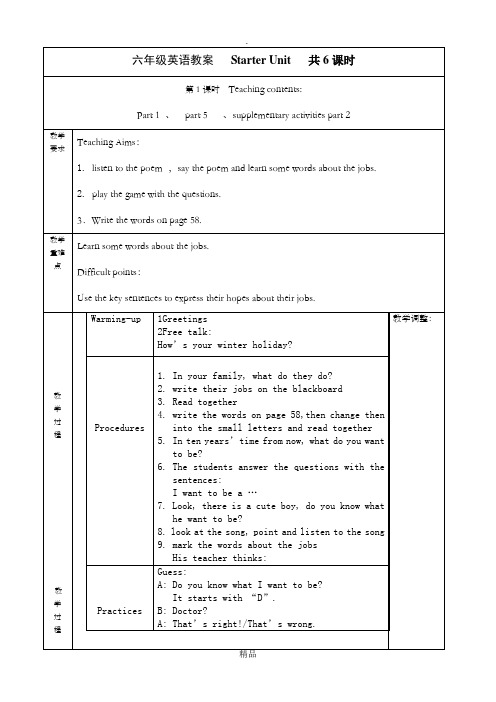
Use“there be”and“have/has got”correctly
教
学
过
程
教
学
过
程
Warming-up
1. Greetings.
2.Free talk:
What do you want to be?
What’s your favourite…?
Procedures
The teacher write : food:……
2.look at the pictures,
write the words under each of the heading in your notebooks
3.check the answers
4.Show the categories on the board
food: chicken、apples、fish、cake、ice cream、
orange juice、vegetable、sandwich、toast、
chips、pear、popcorn、plum…
六年级英语教案Starter Unit
第3课时Teaching contents:
Part 2 、part 4 & part 1 on page 58 (2)
I want to be a…
7. Look, there is a cute boy, do you know what he want to be?
8. look at the song, point and listen to the song
9. mark the words about the jobs
Unit4大单元整体教学设计-2023-2024学年小学英语六年级下册(Joinin外研剑桥英语)
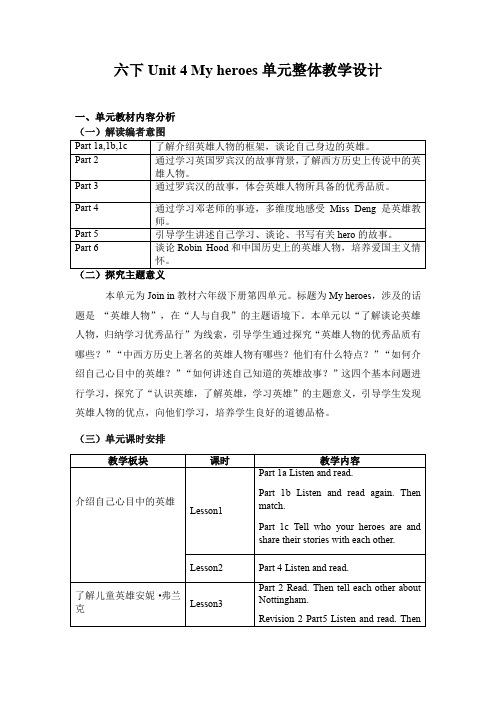
六下Unit 4 My heroes单元整体教学设计一、单元教材内容分析(一)解读编者意图本单元为Join in教材六年级下册第四单元。
标题为My heroes,涉及的话题是“英雄人物”,在“人与自我”的主题语境下。
本单元以“了解谈论英雄人物,归纳学习优秀品行”为线索,引导学生通过探究“英雄人物的优秀品质有哪些?”“中西方历史上著名的英雄人物有哪些?他们有什么特点?”“如何介绍自己心目中的英雄?”“如何讲述自己知道的英雄故事?”这四个基本问题进行学习,探究了“认识英雄,了解英雄,学习英雄”的主题意义,引导学生发现英雄人物的优点,向他们学习,培养学生良好的道德品格。
(三)单元课时安排(四)形成结构图示本单元以“英雄人物”为主题,本单元的语篇,故事之间紧密联系,主要介绍了来自中西方不同国家的英雄人物。
引导学生引导学生发现英雄人物的优点,向他们学习,培养学生良好的道德品格。
具体结构图示如下::单元主题:My heroes主题意义:认识英雄,了解英雄,学习英雄子主题1:介绍自己心目中的英雄子主题2:了解儿童英雄安妮·弗兰克子主题3:了解英雄罗宾汉的故事Lesson 1短文了解介绍英雄人物的框架。
Lesson 4 故事了解罗宾汉的英雄事迹。
Lesson 3 短文了解儿童英雄安妮·弗兰克的事迹。
Lesson 2短文多维度了解英雄教师MissDeng。
Lesson 5短文谈论RobinHood和中国历史上的英雄人物。
子主题4:了解中国历史上的英雄人物二、单元学习目标:1.能有效运用所学的语言框架介绍英雄人物和英雄事迹。
2.能分析、归纳、总结英雄人物的共性特征;对比中西方英雄人物的异同,培养学生善于发现生活中普通人的闪光点,“小人物”也有“大精神”,并乐于向他人学习。
3.能有效整合认知策略和方法,引导学生感受并学习英雄人物的优秀品质,进而体会到英雄既可以是作出贡献的大人物,也可以是生活中值得学习的小人物。
joinin打印六级下册英语—单元教案

Copy ,translate and recite the words.
e.g. e—came see—saw…
教学调整:
板书
设计
Unit 5
e—came see—saw am,is—was
open—opened hear—heard jump--jumped
六年级英语教案Unit 5
教学调整:
板书
设计
Unit 5
My favourite story / cartoon is…
The hero / heroine is a boy / girl…
He / She is…years old.
interestingstories
The book / cartoon is full of a lot of fun
9.listen 2b and check the answers.
10.show the listen material about 2b, then read and understand
Practices
Read the listening materials loudly.
Homework
Copy, translate and recitethesentences
and understand the sentences:
A house without books is like a room without
Practices
1.Show the examples:
2.Read the examples
3.Make sentences with there be
How does Toby read books
Revision1(教案)-2023-2024学年Joinin外研剑桥英语六年级下册

- She enjoys reading books. → She read books last night.
- They are going to the cinema. → They went to the cinema yesterday.
2.引导与启发:在讨论过程中,我将作为一个引导者,帮助学生发现问题、分析问题并解决问题。我会提出一些开放性的问题来启发他们的思考。
3.成果分享:每个小组将选择一名代表来分享他们的讨论成果。这些成果将被记录在黑板上或投影仪上,以便全班都能看到。
五、总结回顾
今天的学习,我们了解了英语交流的基本概念、重要性和应用。同时,我们也通过实践活动和小组讨论加深了对英语交流的理解。我希望大家能够掌握这些知识点,并在日常生活中灵活运用。最后,如果有任何疑问或不明白的地方,请随时向我提问。
- I am learning English. → I learned English last week.
5.根据提示,用一般将来时完成句子:
- I will visit my grandparents next week.
- She will have a party on her birthday.
教学方法与策略
1.教学方法
(1)讲授与讨论相结合:教师首先通过讲授方式,系统地复习重点词汇和语法知识,然后组织学生进行小组讨论,让学生在互动中加深对知识的理解和掌握。
(2)案例分析:教师选取典型的英语运用案例,让学生通过分析案例,理解和掌握词汇和语法知识的实际运用。
(3)项目导向学习:教师设计一个与生活实际相关的项目,让学生在完成项目的过程中,运用所学知识解决问题,提高实际运用能力。
Join in 六年级下册教案 Revision2
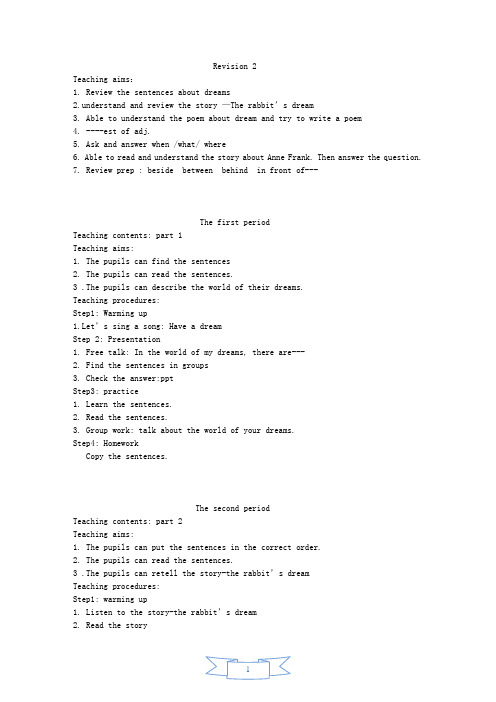
Revision 2Teaching aims:1. Review the sentences about dreams2.understand and review the story —The rabbit’s dream3. Able to understand the poem about dream and try to write a poem4. ----est of adj.5. Ask and answer when /what/ where6. Able to read and understand the story about Anne Frank. Then answer the question.7. Review prep : beside between behind in front of---The first periodTeaching contents: part 1Teaching aims:1. The pupils can find the sentences2. The pupils can read the sentences.3 .The pupils can describe the world of their dreams.Teaching procedures:Step1: Warming up1.Let’s sing a song: Have a dreamStep 2: Presentation1. Free talk: In the world of my dreams, there are---2. Find the sentences in groups3. Check the answer:pptStep3: practice1. Learn the sentences.2. Read the sentences.3. Group work: talk about the world of your dreams.Step4: HomeworkCopy the sentences.The second periodTeaching contents: part 2Teaching aims:1. The pupils can put the sentences in the correct order.2. The pupils can read the sentences.3 .The pupils can retell the story-the rabbit’s dreamTeaching procedures:Step1: warming up1. Listen to the story-the rabbit’s dream2. Read the storyStep2: Presentation1. Put the sentences in the correct order in groups2. Check the answer: pptStep 3 PracticeListen and tick.1. Learn the sentences2 .read sentences in the correct order in groupsStep4Home workCopy the sentencesThe third periodTeaching contents: part 3,6Teaching aims:1. The pupils can read and understand the poem.2. The pupils canwrite a new poem.3.review the –est of adj.Teaching procedures:Step1 warming upFree talk: in the world of my dream---sk and answer:What can you find in your dream?Step2: Presentation1.ppt show the poem: sweetest smells /nicest songs /loveliest people/ most helpful teacher.2.read the poem.3.ppt show the poem: biggest pizza /sweetest ice cream/the most wonderful fruit/ best drinks4.read the poem.Step3 Listen and read1.Listen and read2.read and fill in the blanks3.adj VS ---est of adj.4. ask and answer:Which is the biggest?Who is the tallest?Who is the oldest?Step 4 consolidationWrite a new poem in groupsShow the poemStep5Home workWrite your own poem.The fourth periodTeaching contents: part 4Teaching aims:1. The pupils can ask and answer : When/what/how/where /do/is/who/are/can/have---2. The pupils can play the game in groups.Teaching procedures:Step1 warming up1.greetings and free talk:2.Review the words: When/what/how/where /who ---Step2 Presentation1.ppt show the game2.read the questions one by one3.a game : say out the questions quickly.4.Read the questions in groupsStep3 Practice1.play the game in groups2.Read the sentences.3.play the game in groups and see who is the first to finish,Step 4 ConsolidationTouch and say:Step5Home workPlay the game with your friends.The fifth periodTeaching contents: part 5Teaching aims:1. The pupils can read and understand the text.2. The pupils can tick true or false after reading.Teaching procedures:Step1 warming up1. Sing a song I love reading.Step2 Presentation1.listen and answer:What’s the story about?2.Read the story and try to understand.3.Learn the story and make marks.4.Listen and follow.5.Read the story in groups.6.Tick true or false.7.Check the answer.Step3 PracticeRead the story again and try to underline the sentences.Step 4 ConsolidationRead and choose the right answer:pptStep5Home workTell your friends sth about the child hero-Anne Frank.The sixth periodTeaching contents: part 7, 8Teaching aims:1. The pupils can ask and answer the questions quickly and correctly.2. The pupils can use prep: beside/ between /behind /in front of correctly Teaching procedures:Step1 warming up1.a chant: with actionsbeside/ between /behind /in front of correctly2.Free talkThe questions of part 4.Step2.Presentation1. PPT show the picture of page 56.2, Read beside/ between /behind /in front of correctly3. Fill in the blanks:Who is Elena?Elena is the girl ___________ John and Andy.Who is Peter?Elena is the boy ___________ John .Where is the duck?It’s ________ John.Where is the ir football?It’s ________ John.4. Check the answer5. pictures and sentences:Can you tell me the way to the hospital?What are the children doing under the big tree?Where did your family go on New Year’s Day?Do you sometimes dream of becoming a scientist?When are you going to have your get-together.Step3 PracticeDraw lines.Check the answer,Step 4 ConsolidationRead the questions and answers in order.Step5Home workCopy the sentences and read.The seventh periodTeaching contents: part 9Teaching aims:1. The pupils can tell their favourite things.2. The pupils can use: My favourite ---3. The pupils can make simple introduction.Teaching procedures:Step1 warming up1.review the words: places colours foods sports numbers.3.Free talkWhat’s your name?How old are you?Step2.Presentation1.PPT show my favourite things2,write your own favourite things3.interview:What’s your favourite----?4.group work: ask and answer What’s your favourite----?Step3 PracticeWrite a composition: all about me!My name is Lihui. I am twenty-five years old. My favourite colour is red. My favourite food is fish. My favourite sport is playing football.Step 4 ConsolidationGroupwork: write your own self –introduction.Show timeStep5Home workCopy the sentences and read.write your own self –introduction and read.。
Join in 六年级下册教案 Starter unit Join in us
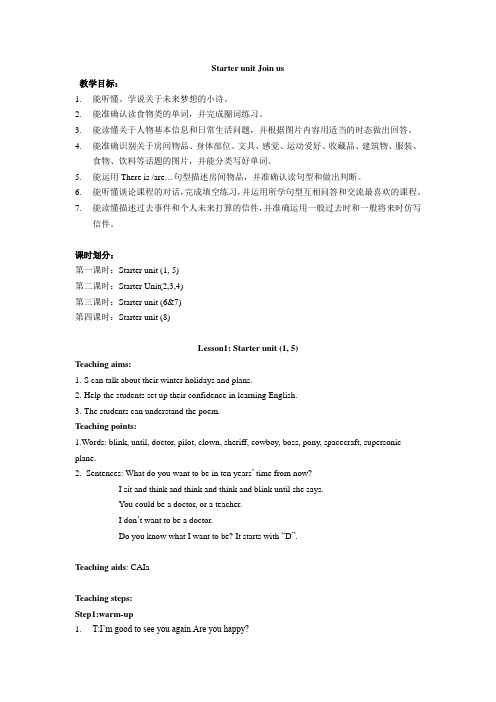
Starter unit Join us教学目标:1.能听懂、学说关于未来梦想的小诗。
2.能准确认读食物类的单词,并完成圈词练习。
3.能读懂关于人物基本信息和日常生活问题,并根据图片内容用适当的时态做出回答。
4.能准确识别关于房间物品、身体部位、文具、感觉、运动爱好、收藏品、建筑物、服装、食物、饮料等话题的图片,并能分类写好单词。
5.能运用There is /are…句型描述房间物品,并准确认读句型和做出判断。
6.能听懂谈论课程的对话,完成填空练习,并运用所学句型互相问答和交流最喜欢的课程。
7.能读懂描述过去事件和个人未来打算的信件,并准确运用一般过去时和一般将来时仿写信件。
课时划分:第一课时:Starter unit (1, 5)第二课时:Starter Unit(2,3,4)第三课时:Starter unit (6&7)第四课时:Starter unit (8)Lesson1: Starter unit (1, 5)Teaching aims:1.S can talk about their winter holidays and plans.2.Help the students set up their confidence in learning English.3.The students can understand the poem.Teaching points:1.Words: blink, until, doctor, pilot, clown, sheriff, cowboy, boss, pony, spacecraft, supersonic plane.2. Sentences: What do you want to be in ten years’ time from now?I sit and think and think and think and blink until she says.You could be a doctor, or a teacher.I don’t want to be a doctor.Do you know what I want to be? It starts with “D”.Teaching aids: CAIaTeaching steps:Step1:warm-up1.T:I’m good to see you again.Are you happy?S: Yes ,I am good to see you again too.2.The students talk about their winter holidays.3.T:Now Chinese New Year is over , and now you are all one year older now. What do you want to be in ten years’ time from now?Step 2:Presentation----What I want to be1.The teacher divides the poem into two parts, and then teaches the new words.2.The teacher shows the pictures about different occupations: doctor, pilot, clown, sheriff,cowboy, boss.3.The teacher explains the useful phrases and sentences in the first part.4.The teacher shows the pictures about different occupations: pony, spacecraft, supersonic plane.5.The teacher explains the useful phrases and sentences in the second part.6.Listen to the poem together.7.Repeat after the tape, then read them together.Step 3:Consolidation1.Play a game: Guess the occupations.S1:Do you know what I want to be? It starts with “D”.S2:Doctor?S1:That’s right.2.Make the dialogues in groups .Step 4:Homework:Practise reading the poem after class.Board designStarter Unitblink, until, doctor, pilot, clown, sheriff, cowboyboss, pony, spacecraft, supersonic planeWhat do you want to be in ten years’ time from now?I sit and think and think and think and blink until she says.You could be a doctor, or a teacher.I don’t want to be a doctor.Do you know what I want to be? It starts with “D”.Lesson 2:Starter Unit(2,3,4)Teaching aims:1.The students can look at the pictures and answer the questions about Simon.2.Help the students set up their confidence in learning English.Teaching points:1.Words : words about things in a room, body, school things, feelings, colours, sports andhobbies, things you can collect, buildings, animals, things you can put on , things you can eat and drink.2.Sentences: Where is Simon from? How old is he?What does he love? Who is Simon’s friends?What do they often do? What do they often do?When did he get up yesterday? When did he get to school?What did he do from 5 to 5 pm? What did he do from 7 to 9 pm? Teaching aids:PPTTeaching steps:Step 1:warm-up1.Ask and answer:T: What do you want to be in ten years’ time from now?Ss answer.2.Read the poem together.Step 2: Presentation1.Show the pictures of Part 4.2.Ask the students to write down their names below the pictures.3.Put the things in the right groups.4.Read the words together.5.Do part 2 on p3.6.Check the answers.Step 3:Consolidation1.Look at the pictures and explain each pictures with the following questions.Where is Simon from? How old is he?What does he love? Who is Simon’s friends?What do they often do? What do they often do?When did he get up yesterday? When did he get to school?What did he do from 5 to 5 pm? What did he do from 7 to 9 pm?2.Ask students to write down the answers.3.Ask and answer in pairs.Step 4:Homework:Ask the students to organize after-school notebook about Part 4.Board designStarter UnitWhere is Simon from? How old is he?What does he love? Who is Simon’s friends?What do they often do? What do they often do?When did he get up yesterday? When did he get to school?What did he do from 5 to 5 pm? What did he do from 7 to 9 pm? Teaching notes:Lesson3: Starter unit (6&7)Teaching aims:1.The students can talk about the room with the structure “there be”.2.The students can use what they have learnt to talk about their favourite subjects. Teaching points:Words: favourite, exerciseSentences: There is a basketball on the floor.There are two frogs under the desk.The socks are on the floor between the bed and the wardrobe.What is your favourite subjects at school and why?My favourite subject is …Because …What about other subjects?Teaching aids: picturesTeaching steps:Step1:warm-up1.Show the pictures of Simon and do some revision about Part 3.2.Ss ask and answer the questions in pairs.Step 2:PresentationPart6: Tick T of F1.Show the pictures of a room. Ask what they can see in the picture.2.Review the words about things in a room.e “There be” to describe where the things are.4.Read the sentences below the pictures. (One read, One translate.)5.Explain the useful and difficult sentences.Part 7:What’s your favourite subjects.1.Do some revisions about subjects.2.Make a dialogue about the students’ favourite subjects, use the following sentences:What is your favourite subject and why?My favourite subject is …Because …What about other subjects?Step 3:Consolidation1.Fill in the blanks.2.Read the dialogues in different ways ( roles, together,groups…)Board designStarter UnitThere is a basketball on the floor. There are two frogs under the desk.The socks are on the floor between the bed and the wardrobe.What is your favourite subjects at school and why?My favourite subject is …Because …What about other subjects?Teaching notes:Lesson4: Starter unit (8)Teaching aims:1.The students can understand the letters.2.Help the students develop the ability to communicate with others.Teaching points:1.Words: yesterday, Mother’s Day, bought, made, tomorrow2.Sentences: I had a fun day yesterday.I bought flowers for my mother.I made a cake.Tomorrow I will play football with my friends in the park after school.Teaching aids: CAITeaching steps:Step1:warm-upThe students talk about their favourite subjects and why.T: What is your favourite subject at school and why?S: My favourite subject is …Because it’s …Step 2:Presentation1.Learn the new words: Mother’s Day, bought, made, tomorrow.2.Listen to the tape, answer the following questions.What was a special day yesterday?What did he do for his mother?What will he do tomorrow?3.Listen to the tape again, fill in the blanks.4.He flowers for his mother. He a cake,too. He the room. HeTV. His mother very happy. Tomorrow he football with his friends in the park after school.Step 3:Consolidation1.Write a reply, including following questions:What about you?What did you do yesterday?What will you do tomorrow?2.The students read their letters in class.Board design:Starter unitbuy ——bought make ——made clean ——cleanedI had a fun day yesterday. I bought flowers for my mother.Teaching notes:。
- 1、下载文档前请自行甄别文档内容的完整性,平台不提供额外的编辑、内容补充、找答案等附加服务。
- 2、"仅部分预览"的文档,不可在线预览部分如存在完整性等问题,可反馈申请退款(可完整预览的文档不适用该条件!)。
- 3、如文档侵犯您的权益,请联系客服反馈,我们会尽快为您处理(人工客服工作时间:9:00-18:30)。
7.Look at the pictures and answer the questions
Practices
Check the answers in pairs, then ask and answer in pairs.
Homework
Write about your breakfast, lunch and supper.
2.Do exercises and review the tense.
Difficult points:
Use the tense correctly and skillfully.
教
学
过
程
教
学
过
程
Warming-up
1.Greetings
2.Free talk
Procedures
1.Show some verbs to read.
1.Read the words, then circle in matching colours.
2.Food riddles. Write the name and draw a pictures of the food in the box.
Look at the picture. Then tick of cross.
Difficult points:
Write down the posterwiththe mirror correctly.
教
学
过程教学源自过程Warming-up
1.Greetings
2.Free talk:
Do you like Mary
What do you know about Mary
Procedures
Look and then answer the questions.
教学重难点
Important points:
1.talk and write about the Koala.
2.look at the pictures and answer the questions about the eating habits.
教学重难点
Important points:
Do exercises correctly and skillfully.
Difficult points:
Understand the family tree and talk about the family members
教
学
过
程
教
学
过
程
Warming-up
4. Look and complete the sentences.
What is Toby doing
5. Read and check the answers.
6. Look at the picture in Part 8,
What is the boy doing in the pictures
Read the questions and the answers together
3.Match and fill in the numbers alone.
4.Then listen and check.
5.Read the questiongs and the corresponding answers together.
He / She is a _____.
Procedures
1.Look at the word list, let’s read together.
2.Check the homework:
What food and drinks do you circle
What family members do you circle
Then guess the riddle,
6.Look at the picture in Part 5,
What do you know
Practices
Discuss :
What makes a healthy diet
Homework
Copy, read and try to recite the healthy habits on the notebooks.
Procedures
1.It is important to read correctly and skillfully about the cute animal
2.Show a picture of the Koala
Ask some questions:
What animal is it
Where is it from
Difficult points:
Talk about the eating habits and answer the questions correctly.
教
学
过
程
教
学
过
程
Warming-up
part 6 in Unit 1 loudly
Then answer some questions about Liza, Australia, Koala and Sydney
1.Review about Mary in Unit 3
Read the texts about Mary.
Show some sentences about Mary, then try to tell the correspongding questiongs
2.Look at the exercise 6,
3.Turn to page 31, fill in the blanks.
Read the text to check the answers.
4.Question: What food does the Koala eat
5.Free talk:
6.Let’s talk about Peter. He has very good eating habits.
Look, write and read.
教学重难点
Important points:
1.Review Mary’s diary, read to understand the diaries, then match the questions and the answers.
2.Look at the poster with the mirror, write down and read loudly.
What are they
What else do you know
Write down on the board.
Read together.
2.fill in the blanks with the corresponding forms
3. Pay attention to“be doing”
Eg: What is Mike doing
What are your parents do
教学调整:
板书
设计
Revision 1
Do be doing
六年级英语教案Revision 1
第5课时 part 10 & part 11
教学
要求
Teaching Aims:
1.Fill in the blanks.
教学调整:
板书
设计
8.read together again, then close the books, and translate in English
9.Let’s go back to Unit 1, and read aboutLiza.( 1a, 4a, 6)
Practices
Read your text for your partner.
3.Ask and answer:
What food do you like
What’s your favourite food
4.There are food riddles. Can you guess
5.Show the riddles one by one.
Read together and understand the riddle,
Copy, readthequestiongs and thecorresponding answers in Part 6.
教学调整:
板书
设计
Revision 1
Hi, meet me tonight
at twelve
六年级英语教案Revision 1
第4课时 part 8 & part 9
教学
要求
6.Close the books, try to answer the questions orally.
7.Show the poster,
What can you see
Practices
Close the books ,and try to recite the poster.
Homework
Who is Bill
Who is father
…
4.Guess:Who is AWho is B
5.Fill in the correct words alone
6.check the answers
choose someone read out the sentences
7.read the sentences together
And find out the mistakes to correct.
